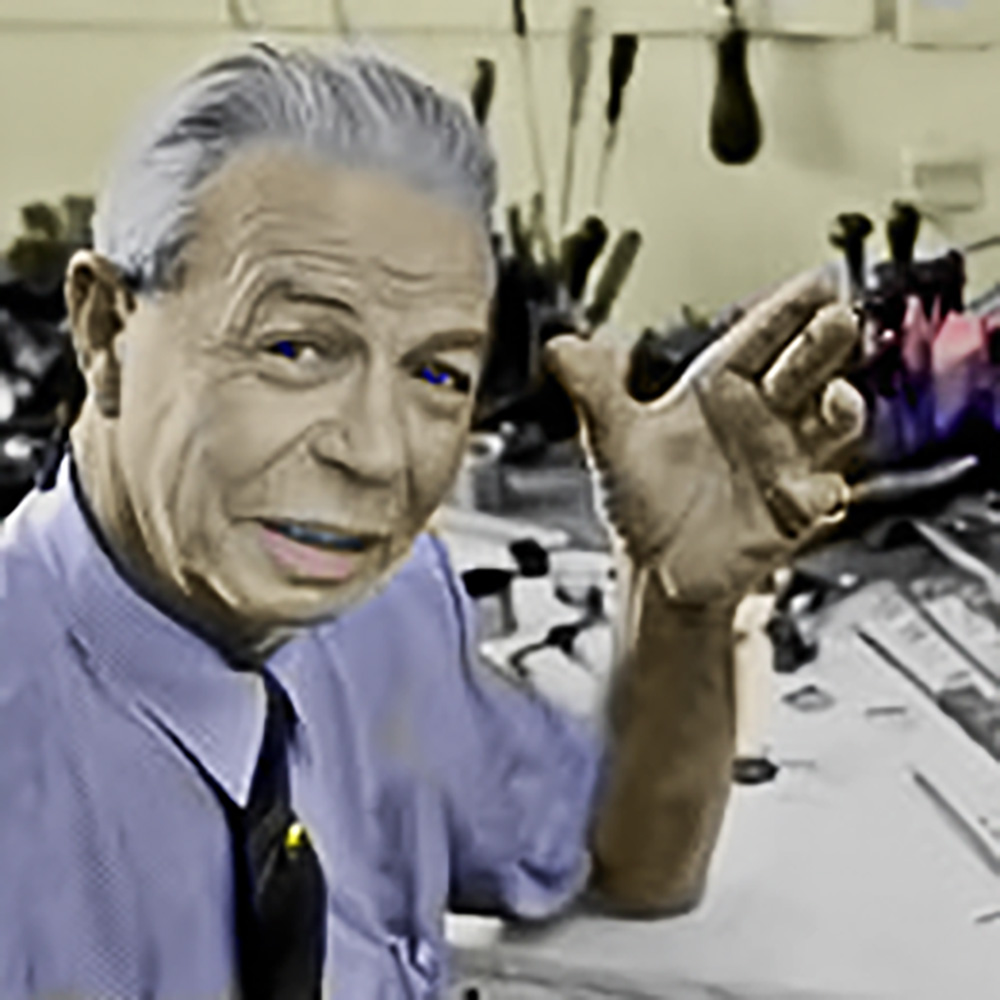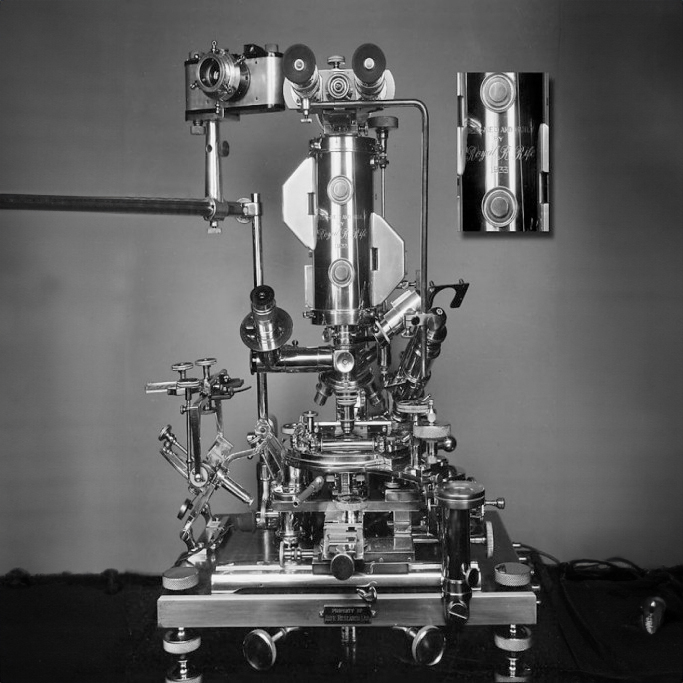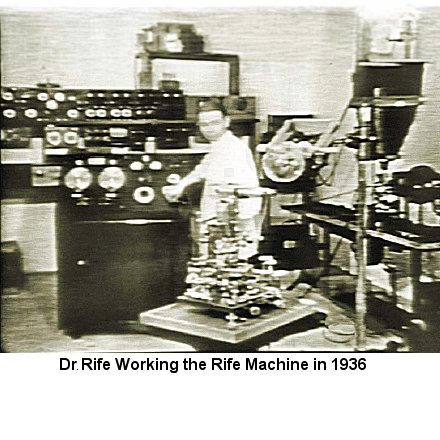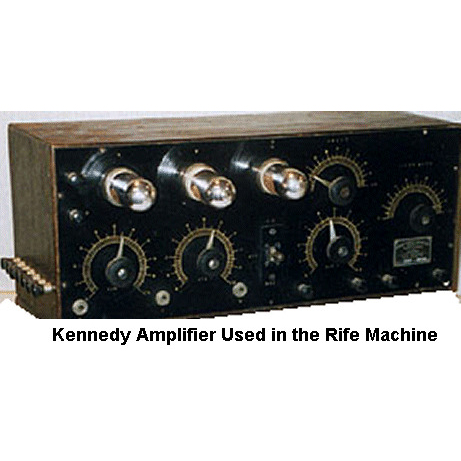
In a letter dated October 15, 1935, Dr. Milbank Johnson explained to a cancer foundation why Rife and he couldn’t stop their work and do special tests which the foundation wanted: “From what I have said I don’t want you to jump to the conclusion that we are not interested in your side of the problem because we are, but with the limited means at our disposal we don’t like to break into our planned procedure at this most interesting juncture of the work. You know in mountain climbing better progress is made to keep going up and up all the time. If you stop and go back every once in awhile, you are very apt to wear yourself out and waste your energies and never reach the top. This is about all I can say until I have discussed the matter fully with Mr. Rife.” Indeed 1935 was a year of mountain climbing. Rife built new, more accurate Royal Rife Machines.
He began planning a new laboratory. He built a smaller microscope which could be mass produced. Research continued. The second clinic was opened. Visitors came-a well-known cancer expert, a representative from the cancer foundation, an associate of Dr. Meyer at the Hooper Foundation in San Francisco who had to be trained so that the Rife experiments could be independently verified. And always there was pressure to announce the findings. Newall Jones of the San Diego Evening Tribune had written Rife a letter in December 1934 and talked to him on the telephone after Jones discovered what was going on at the 1934 cancer clinic. He promised to handle the story carefully and, with Rife, to plan the story in advance. Jones fully understood the significance of what Rife was doing. Jones: “If your research comes to a successful conclusion, it would not only constitute a remarkable contribution to medicine and science-that goes without saying-but, because of its importance to all humanity, would quite naturally be a great news story. Naturally, we would like to get that story.” Jones would have to wait three and a half years.
In May 1938 he would write the clearest explanations of the Rife discoveries which would ever appear in a newspaper. In early March 1935, Johnson received a letter from the International Cancer Research Foundation in Philadelphia. There were many questions they wanted answered, plus photographs of the laboratory, and photographs of the microscope. From this communication began a series of exchanges, proposals and visits which ultimately produced nothing. In retrospect, part of the failure can be seen as simple human misunderstanding, but the time wasted over the next year and a half can also be judged as the fault of pettiness, arrogance and narrow-minded obstinacy on the part of the International Cancer Research Foundation, particularly its rigid Secretary, Dr. Mildred Schram.
The Foundation was in a position to fund Rife in such a way that major advances could have quickly resulted. Instead, they argued for tests which were not relevant. They wasted Rife’s time by having him make a demonstration in Philadelphia the next year, and then they failed to keep their agreement on the techniques he showed them, instead insisting on their own – which ruined the procedure. In their example also lies one of the dilemmas of modern research. The experts have their own way of doing things. The great scientist who is an outsider is looked down upon by the “authorities”-those with the “credentials.” The goal of curing cancer becomes secondary. The existing procedures take precedence. In the exchanges between Johnson and the International Cancer Research Foundation can be seen the institutional strait jackets which also bind modem scientists.
With 460,000 Americans dying of cancer every year, the widest variety of cancer treatments should be encouraged. Unfortunately, such a program would encroach on the territory and the financial income of the established “experts.” By June 1935 the International Cancer Foundation reported to Johnson that four insurance companies were interested in financing Rife if the foundation gave its approval. The foundation asked to send its representative to visit Rife’s laboratory. Dr. Mildred Schram, Secretary of the Foundation, arrived at the end of July 1935, but it was a hurried visit because of her other West Coast commitments. Johnson wrote back to her in December: “The next time you come I hope you will not be loaded down with any other duties so that you can give your undivided attention to our work.”
Dr. Walker, who is an expert in his line, spent three weeks familiarizing himself with our technique and the microscope, so, in the short time you had it was impossible for you to get more than a smattering idea of what we are driving at.” Schram replied that she expected Rife to cultivate and identify the causes of the disease in mice she had shipped to Rife. It was as if they were to pass an examination! Johnson wrote back that they were completing the new Royal Rife Machines, had focused for years on the cancer virus in humans and couldn’t be expected to undertake the kind of work the foundation expected-identifying the cancer micro-organisms in different mice. Johnson declared: “Trying to cultivate strange germs and identify them in malignant tissue is just about as difficult and tedious a job as one can undertake and does not want interruption if a worthwhile job is to be done. We could not at that particular time have followed out your instructions and desires even if we had understood them.”
William H. Donner, President of the International Cancer Research Foundation, had become “deeply interested” in Rife and his discoveries. So Schram stayed in contact. Nevertheless, she insisted on the test she had designed. In mid-October 1935, Johnson tried again to explain: “I don’t think you can really appreciate what it means to culture three unknown organisms, if there are that many, ascertain the M.O.R. (Mortal Oscillatory Rate) for each of them, and later on to take a series of animals and attempt to destroy that organism. As you know, our work thus far has been devoted exclusively to human cancer, and a single organism which we have found up to this time always present in human cancer has taken a tremendous lot of time already to study the life history and the life cycle of that one. I am not sure that Mr. Rife or our Committee would wish to drop that work and undertake this much larger problem of studying the different hyperplasias and tumors that might occur in different strains of mice which may or may not have a relation to human carcinoma.” Johnson suggested that the foundation President William Donner take his winter vacation in San Diego instead of Bermuda or Florida. But Donner was neither a doctor nor a bacteriologist. He was a steel executive, bank trustee and corporate mogul. Schram was the professional power at the foundation. She wrote back immediately stating her tests were necessary if the foundation was to put up any money. She insisted that they do the tests as she specified.
In December 1935, Schram informed Johnson that action had been deferred on his grant request. But she relented on her test. The possibilities of Rife’s cure were too important to dismiss on her personal whim, especially when so many experts-bacteriologists, doctors and microscopists were talking about Rife’s work. So, instead of her test, she asked for detailed information on the cancer clinic of 1934, insisting that the well-known Dr. Dock of Johnson’s Special Research Committee provide it. If the material provided was sufficient, she indicated, a grant might be forthcoming. She then also admitted that her tests really weren’t necessary once the research grant was bestowed. They had been required previously only to get the grant! Exactly 9 months had passed, most of that time wasted because of Schram’s narrow-minded insistence on a procedure of her design. Johnson’s exasperation showed in his reply. He explained the kind of clinical records that did exist and pushed for a simpler solution-a foundation representative in Rife’s laboratory for a few weeks. Johnson: “You are right in protecting your funds from waste. But, I still think that a properly qualified scientist or clinician could learn more in two weeks by actually trying the things himself than he can learn by correspondence in a year.”
Nevertheless, Johnson did manage to get Rife to describe the Royal Rife Machine and he did call a meeting of the Special Medical Research Committee of the University of Southern California. Dr. Dock would be leaving a week later for a trip around the world, so it is assumed that some statement of the full committee, including Dock, was Johnson’s goal-in order that the foundation could have a basis for a grant. However, after another year of correspondence and meetings, nothing would come of the effort. The interaction with the International Cancer Research Institute was only one element of Johnson’s and Rife’s “mountain climb” in 1935. Far more important was the visit from Cameron Gruner, a well-known cancer researcher from Montreal. Gruner would bring his own discovery just as Kendall had done in 1931, and Rife would take Gruner’s discovery and join it with Kendall’s and his own. The result would be another breakthrough.
Gruner had taken blood from his cancer patients and from it, on an Asparagus Medium, had grown a fungus. Rife put Dr. Gruner’s fungus in the “K Medium” and then filtered from it Rife’s own BY virus. He then put some of his earlier BX on Gruner’s Asparagus Medium and brought forth Gruner’s fungus. Another form of the cancer micro-organism had been isolated – a fungus! Rife now had a solid base for pleomorphism. Not only could the BX virus live on an artificial medium, but the BX could change into another form in the blood (the monococcoid form in the monocytes of the blood of over 90% of cancer patients) and then into still another form – a crytomyces pleomorphia fungus. Rife conclusively stated in his 1953 report: “This BX virus can be readily changed into different forms of its life cycle by the media upon which it is grown.”
In 1937, Milbank Johnson wrote a letter describing what Dr. Gruner and Royal Rife had discovered in May-June 1935: “Dr. Gruner was present at all the experiments and we agreed – I think beyond a doubt-that our BX and the organism which he obtained from the blood, although in a different form from our BX, are one and the same organism. It looks, therefore, as if we know how to produce at will, by means of the appropriate culture, any one of the three forms desired.” Dr. Schram at the International Cancer Research Institute was informed of this discovery. Part of the proposed grant was to be used to bring Dr. Gruner to San Diego for a year to work alongside Rife. Schram referred in one letter to the “Gruner-Johnson-Rife organism.” In light of Dr. Gruner’s reputation in cancer research and the discovery resulting from his experiments with Rife, Schram’s prolonged insistence on a test of her design, which she later admitted was not central to the grant, demonstrates how the “system” then and today often operates: on the basis of personal priorities disguised as professional requirements.
In May 1935, Johnson also began looking for a location in Los Angeles for a new clinic. It presented a bit of a problem because the electric current had to be 60 cycles for the new Royal Rife Machine. Finally the Santa Fe Hospital at 610 South Saint Louis Street on a comer with East Sixth Street in Los Angeles was chosen. The clinic opened the first week of November 1935 with Johnson in charge. Treatments were given two days a week, and this time Johnson was keeping careful clinical records. The new Royal Rife Machine was finished in December 1935. Rife, his new assistant Philip Hoyland, his earlier assistant Jack Free, and Milbank Johnson then put the new machine into operation. Johnson explained the process: “The new Royal Rife Machine had arrived at its point of construction when elaborate tests had to be made in order to synchronize the M.O.R. produced by it with the M.O.R. produced by the old machine. Now, we are in the throes of accurately charting the 14,000 possible settings on the new machine. Our next process, beginning next week, is to test its penetration, the time required in the different exposures, the different depths of lesions. So, take it altogether we are just about as busy as a bear in berrytime.”
Later that year, Rife provided a brief description of the Royal Rife Machine, presumably because of the Foundation”s request: “The basic principle of this device is the control of a desired frequency. These frequencies varying upon the organism being treated. “The frequency is set which controls the initial oscillator, which in turn is run through six stages of amplification, the last stage driving a 50 watt output tube. “The frequency with its carrier wave is transmitted into an output tube similar to the standard X ray tube, but filled with a different inert gas. This tube acts as a directional antenna. “The importance in the variable control of these frequencies is that each pathogenic organism being treated is of a different chemical constituency, the consequence being they carry a different molecular vibratory rate. Each one in turn under these conditions requires a different frequency or vibratory rate to destroy .” The new instrument was light-socket powered and had an output of 500 watts. Furthermore, it was equipped to deliver two distinct frequencies simultaneously and both variable. This apparatus proved to be more efficient with decidedly fewer factors of error. Rife also – amazing as it seems given everything else occurring in his life – built a new, smaller microscope. While the “Universal” microscope of 1933 cost between $30,000- $35,000 to construct, according to Johnson, the 1935 microscope was theoretically priced to be sold at $1,000 or less. The purpose was to make many of the smaller microscopes available to research laboratories. The new microscope still had a magnification range of 10,000 times to 15,000 times far beyond what the “best” light microscopes available could do.
Then there was Dr. Walker’s visit of three weeks. This occurred in August after his boss, Dr. Karl Meyer, had established the training session when Meyer visited Rife on June 28, 1935. Walker learned about the laboratory procedures, about the “BX” virus (carcinoma), about the “BY” virus (sarcoma), and about the Rife microscope. He then returned to San Francisco to work with Dr. Karl Meyer at the Hooper Foundation. Later, he was provided a Rife microscope of his own. In October 1935, Dr. Walker wrote: “The copy of the results of your test of the Royal Rife Machine on typhoid organisms would appear to establish conclusively the efficiency of it to kill these organisms in the tissues. If the Royal Rife Machine should prove equally efficient in killing other pathogenic micro-organisms, it would be the greatest discovery in the history of therapeutic medicine.” Walker soon found that his work would be far more difficult than he originally envisioned. He eventually would isolate a BX on his own with old antiquated equipment provided by Rife, but not before he experienced shock at the lack of support he received from his colleagues.
One of his letters in late 1935 referred to his being held up by a mercenary person. Another letter tells how the surgeons in San Francisco wouldn’t cooperate – they wouldn’t provide any cancer tissues! And throughout 1935, Johnson was keeping an eye on some of the patients from the 1934 cancer clinic. In May he wrote Rife and asked him to visit Tom Knight, the patient whose healing had so impressed Arthur Kendall and whose tumor Kendall had measured so carefully. Johnson to Rife: “You will find Tom’s address on your copy of his case record. I want you to have a look at old Tom yourself and see whether there is any recurrence of the cancer, either on the face or in the glands, also, look at his lip.” In October, Johnson wrote Rife’s assistant to look up the M.O.R. for the disease they treated in another 1934 patient, Wayne Grayson. Johnson explained he had the man’s clinical record, but he had failed to record the M.O.R. at the time of treatment. As the year ended, the Special Medical Research Committee of the University of Southern California met to analyze the progress. The meeting was held on December 26 in Los Angeles. And indeed the progress of 1936 was phenomenal – a new Royal Rife Machine, a new microscope, a second clinic underway, the historic discovery with Dr. Gruner of Montreal, the training of Dr. Walker of San Francisco. Only the fiasco with the International Cancer Research Foundation marred the “going up and up all the time” as Rife, Johnson and their gathering band attacked the mountain.



